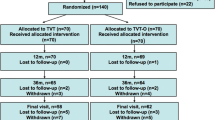Abstract
Introduction and hypothesis
The adjustable transvaginal tape (TVA) has shown to allow adjustment of tension thus permitting correction of postoperative incontinence or obstruction. An adjustable transobturator mesh has been checked.
Methods
Seventy-seven incontinent women received transobturator adjustable tape (TOA). Patients were monitored 1, 6, and 12 months post-surgery and annually thereafter by medical history, cough stress test, flowmetry, post-void residual (PVR), and incontinence quality of life, international consultation on incontinence-short form, and patient global impressions of improvement (PGI-I) questionnaires.
Results
After adjustment, all patients rendered continent; none had PVR. On no occasion was vesical catheterization necessary. Mean follow-up was 24.7 ± 10.3 months. Objective cure rate was 90% with 6.5% having greatly improved. The PGI-I questionnaire showed 90.7% of patients to be better or very much better than before. Q max was 21.3 ± 7.2 ml/s. No infection was identified. Vaginal extrusion occurred in one patient.
Conclusions
Our data demonstrate that the TOA allows postoperative adjustment of tension thus permitting correction of postoperative incontinence or obstruction.



Similar content being viewed by others
References
Porena M, Costantini E, Frea B, Giannantoni A, Ranzoni S, Mearini L et al (2007) Tension-free vaginal tape versus transobturator tape as surgery for stress urinary incontinence: results of a multicentre randomised trial. Eur Urol 52:1481–1490
Zullo MA, Plotti F, Calcagno M, Marullo E, Palaia I, Bellati F et al (2007) One year follow-up of tension-free vaginal tape (TVT) and transobturator tape (TVT-O) for surgical treatment of female stress urinary incontinence: a prospective randomised trial. Eur Urol 51:1376–1384
Morey AF, Medendorp AR, Noller MW, Mora RV, Shandera KC, Foley JP et al (2006) Transobturator versus transabdominal mid urethral sling: a multi-institutional comparison of obstructive voiding complications. J Urol 175:1014–1017
Romero Maroto J, Ortiz Gorraiz M, Prieto Chaparro L, Pachero Bru JJ, Miralles Bueno JJ, Lopez Lopez C (2008) Transvaginal adjustable tape: an adjustable mesh for surgical treatment of female stress urinary incontinence. Int Urogynecol J Pelvic Floor Dysfunct 19:1109–1116
Juang CM, Yu KJ, Chou P, Yen MS, Twu NF, Horng HC et al (2007) Efficacy analysis of trans-obturator tension-free vaginal tape (TVT-O) plus modified Ingelman-Sundberg procedure versus TVT-O alone in the treatment of mixed urinary incontinence: a randomized study. Eur Urol 51:1671–1679
Davila GW, Johnson JD, Serels S (2006) Multicenter experience with the Monarch transobturator sling system to treat stress urinary incontinence. Int Urogynecol J Pelvic Floor Dysfunct 17:460–465
de Tayrac R, Deffieux X, Droupy S, Chauveaud-Lambling A, Calvanèse-Benamour L, Ferandez H (2004) A prospective randomized trial comparing tension-free vaginal tape and transobturator suburethral tape for surgical treatment of stress urinary incontinence. Am J Obstet Gynecol 190:602–608
Salin A, Conquy S, Elie C, Touboul C, Parra J, Zerbib M et al (2007) Identification of risk factors for voiding dysfunction following TVT placement. Eur Urol 51:782–787
Sander P, Sorensen F, Lose G (2007) Does the tension free vaginal tape procedure (TVT) affect the voiding function over time? Pressure-flow studies 1 year and 3 1/2 years after TVT. Neurourol Urodyn 26:995–997
Kaum HJ, Wolf F (2002) TVT: on midurethral tape positioning and its influence on continence. Int Urogynecol J Pelvic Floor Dysfunct 13:110–115
Hong B, Park S, Kim HS, Choo MS (2003) Factors predictive of urinary retention after a tension free vaginal tape procedure for female stress urinary incontinence. J Urol 170:852–856
Wheeler TLII, Ritchter HE, Greer WJ, Bowling CB, Redden DT, Varner RE (2008) Predictors of success with postoperative voiding trials after a midurethral sling procedure. J Urol 179(2):600–604
Schrafford Koops SE, Bisseling TM, van Brummen HJ, Heintz AP, Vervest HA (2007) Results of the tension-free vaginal tape in patients with concomitant prolapse surgery: a 2-year follow-up study. An analysis from the Netherland TVT database. Int Urogynecol J Pelvic Floor Dysfunct 18:437–442
Costantini E, Lazzeri M, Bini V, Del Zingaro M, Zucchi A, Porena M (2008) Burch colposuspension does not provide any additional benefit to pelvic organ prolapse repair in patients with urinary incontinence: a randomized surgical trial. J Urol 180:1007–1012
Brubaker L, Cundiff GW, Fine P, Nygaard I, Richter HE, Visco AG et al (2006) Abdominal sacrocolpopexy with Burch colposuspension to reduce urinary stress incontinence. N Engl J Med 2006(354):1557–1566
Doo CK, Hong B, Chung BJ, Kim JY, Jung HC, Lee KS et al (2006) Five-year outcomes of the tension-free vaginal tape procedure for treatment of female stress urinary incontinence. Eur Urol 50:333–338
Munir N, Bunce C, Gelister J, Briggs T (2005) Outcome following TVT sling procedure: a comparison of outcome recorded by surgeons to that reported by their patients at a London district general hospital. Eur Urol 47:635–640
Ward KL, Hilton P (2004) A prospective multicenter randomized trial of tension-free vaginal tape and colposuspension for primary urodynamic stress incontinence: two-year follow-up. Am J Obstet Gynecol 190:324–331
Kobashi K, Govier F (2005) The completely dry rate: a critical re-evaluation of the outcomes of slings. Neurourol Urodyn 24:602–605
Haab F, Trockman BA, Zimmern PE, Leach GE (1997) Results of pubovaginal sling for the treatment of intrinsic sphincter deficiency determined by questionnaires analysis. J Urol 158:1738–1741
Acknowledgements
The Urology Research Foundation of the Spanish Urology Association has contributed with economic support in this study.
Conflicts of interest
Prof. J. Romero Maroto has a patent pending. International application no. PCT/ES03/00128.
Author information
Authors and Affiliations
Corresponding author
Rights and permissions
About this article
Cite this article
Romero Maroto, J., Ortiz Gorraiz, M., Miralles Bueno, J.J. et al. Transobturator adjustable tape (TOA) permits to correct postoperatively the tension applied in stress incontinence surgery. Int Urogynecol J 20, 797–805 (2009). https://doi.org/10.1007/s00192-009-0872-3
Received:
Accepted:
Published:
Issue Date:
DOI: https://doi.org/10.1007/s00192-009-0872-3




